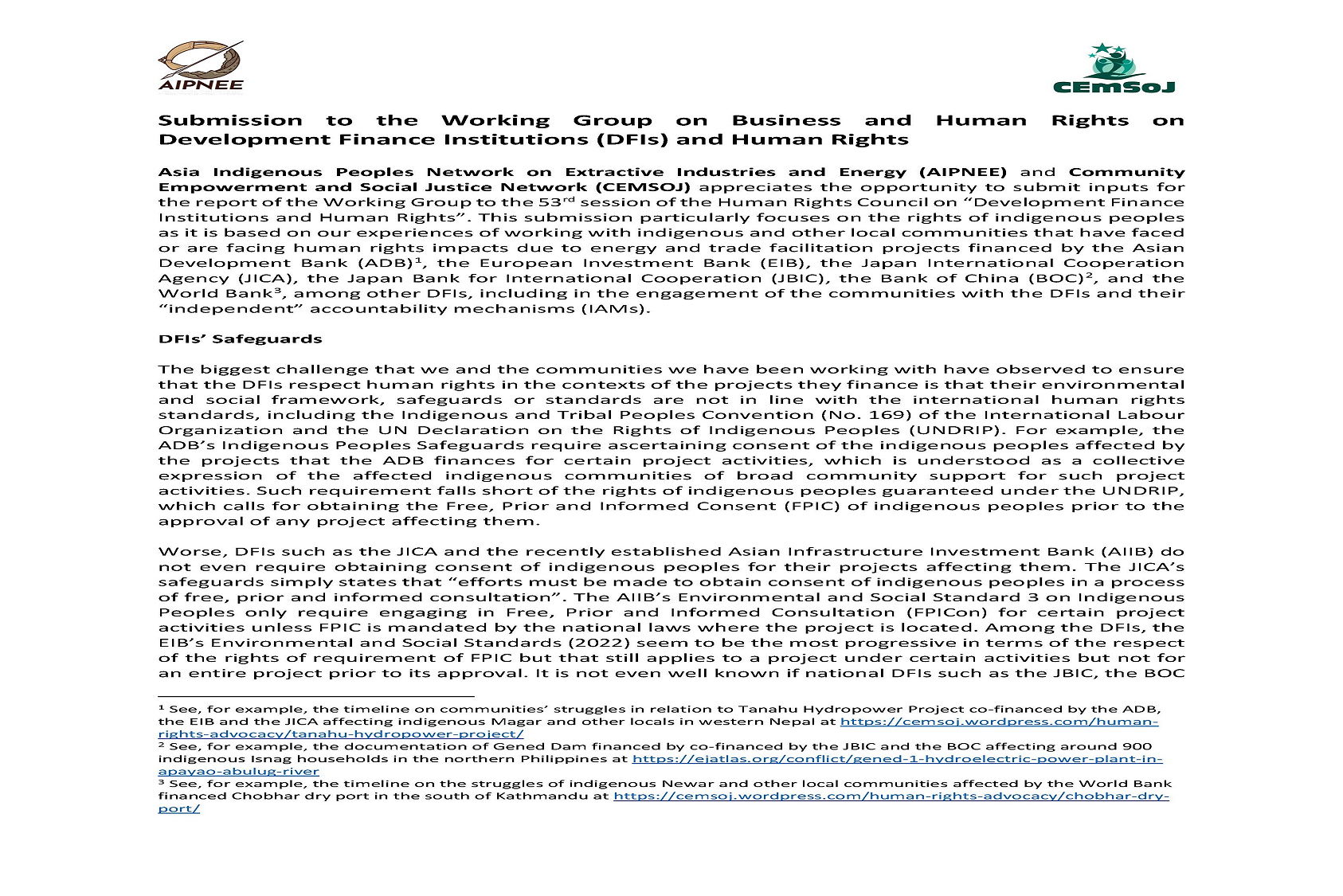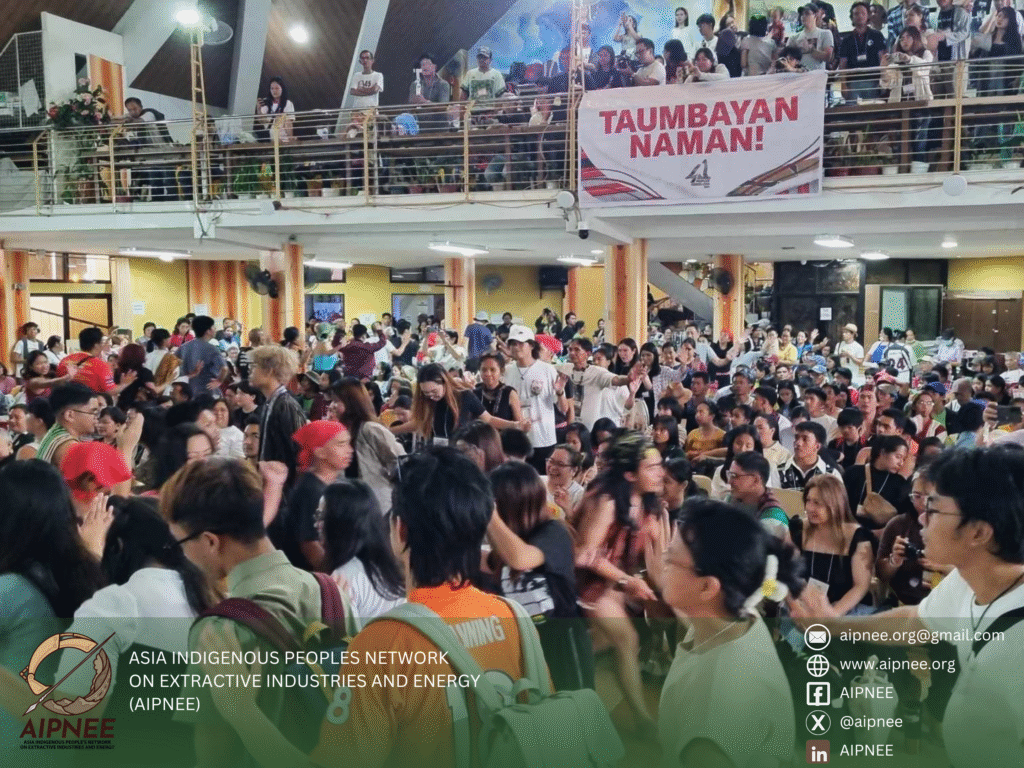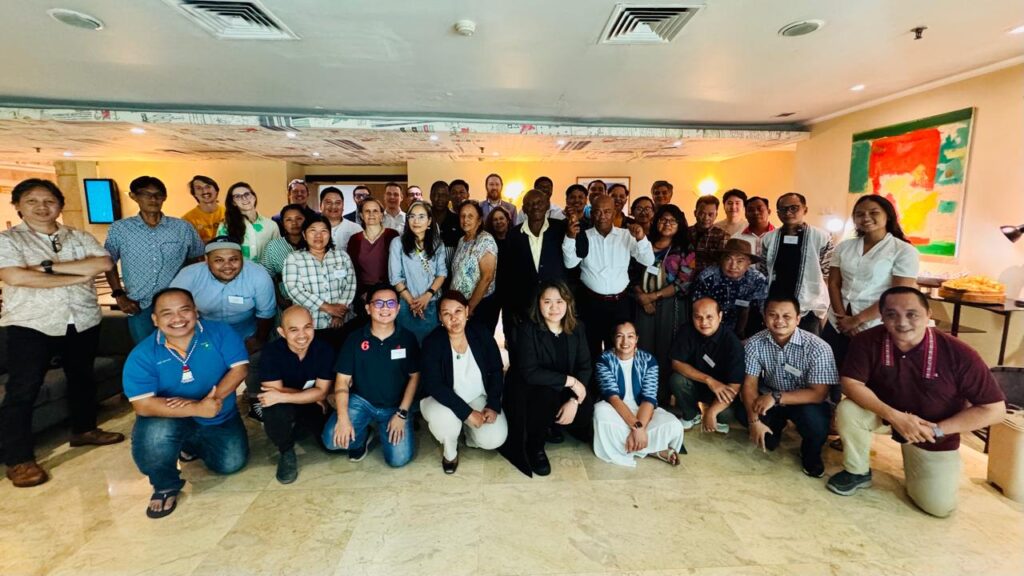Below is the joint submission made by Asia Indigenous Peoples Network on Extractive Industries and Energy (AIPNEE) and Community Empowerment and Social Justice Network (CEMSOJ) to the UN Working Group on Business and Human Rights for their forthcoming report on “Development Finance Institutions (DFIs) and Human Rights”. The submission particularly focuses on the rights of indigenous peoples based on the experiences of AIPNEE and CEMSOJ of working with indigenous and other local communities that have faced or are facing human rights impacts due to energy and trade facilitation projects financed by various DFIs.
Click here for the PDF of the submission.

Asia Indigenous Peoples Network on Extractive Industries and Energy (AIPNEE) and Community Empowerment and Social Justice Network (CEMSOJ) appreciates the opportunity to submit inputs for the report of the Working Group to the 53rd session of the Human Rights Council on “Development Finance Institutions and Human Rights”. This submission particularly focuses on the rights of indigenous peoples as it is based on our experiences of working with indigenous and other local communities that have faced or are facing human rights impacts due to energy and trade facilitation projects financed by the Asian Development Bank (ADB)1, the European Investment Bank (EIB), the Japan International Cooperation Agency (JICA), the Japan Bank for International Cooperation (JBIC), the Bank of China (BOC)2, and the World Bank3, among other DFIs, including in the engagement of the communities with the DFIs and their “independent” accountability mechanisms (IAMs).
DFIs’ Safeguards
The biggest challenge that we and the communities we have been working with have observed to ensure that the DFIs respect human rights in the contexts of the projects they finance is that their environmental and social framework, safeguards or standards are not in line with the international human rights standards, including the Indigenous and Tribal Peoples Convention (No. 169) of the International Labour Organization and the UN Declaration on the Rights of Indigenous Peoples (UNDRIP). For example, the ADB’s Indigenous Peoples Safeguards require ascertaining consent of the indigenous peoples affected by the projects that the ADB finances for certain project activities, which is understood as a collective expression of the affected indigenous communities of broad community support for such project activities. Such requirement falls short of the rights of indigenous peoples guaranteed under the UNDRIP, which calls for obtaining the Free, Prior and Informed Consent (FPIC) of indigenous peoples prior to the approval of any project affecting them.
Worse, DFIs such as the JICA and the recently established Asian Infrastructure Investment Bank (AIIB) do not even require obtaining consent of indigenous peoples for their projects affecting them. The JICA’s safeguards simply states that “efforts must be made to obtain consent of indigenous peoples in a process of free, prior and informed consultation”. The AIIB’s Environmental and Social Standard 3 on Indigenous Peoples only require engaging in Free, Prior and Informed Consultation (FPICon) for certain project activities unless FPIC is mandated by the national laws where the project is located. Among the DFIs, the EIB’s Environmental and Social Standards (2022) seem to be the most progressive in terms of the respect of the rights of requirement of FPIC but that still applies to a project under certain activities but not for an entire project prior to its approval. It is not even well known if national DFIs such as the JBIC, the BOC and the Export-Import (EXIM) banks, which have been increasing their development financing, even have any environmental and social safeguards applicable for the projects they finance.
The Environmental and Social Safeguards, Standards or Framework of DFIs should be fully aligned with the international human rights law and standards, including the ILO Convention 169 and the UNDRIP in the context of the rights of indigenous peoples. Specifically, the DFIs should explicitly require obtaining the FPIC of the concerned indigenous peoples prior to approval of any project they finance affecting the indigenous peoples.
Further, for a project co-financed by various DFIs, it is very difficult for the project-affected marginalized communities to understand different Safeguards/Standards of each DFI that apply to the project. So, the Safeguards, Standards or Framework of all the DFIs should be streamlined to make them similar if not the same with the aim to achieve the best Standards and Safeguards in line with the international human rights standards instead of going for lower or existing standards as we have experienced in the ongoing Safeguards review process of the ADB. Additionally, the DFIs should ensure that their clients or project implementers as well as other stakeholders (such as concerned government authorities) fully understand the requirements under the Safeguards and their applicability beyond national legal provisions if the laws have lesser requirements to protect and respect rights.
Access to remedy
The other major challenge that we have observed is in relation to the engagement of the communities affected by the DFI-financed project to access remedy with the IAMs of the DFIs. Firstly, not all DFIs, particularly national, sub-regional and regional DFIs, have established IAMs while the existing IAMs lack mandate and scope to effectively address the grievances of the affected communities to ensure their access to remedy for the project impacts. For example, even when IAMs find credible evidence of non-compliance with the Safeguards and significant impacts on the affected communities, they cannot recommend suspension of project financing – that is often the first ask of the communities to avoid further harms – until the grievances are addressed. Their recommendations are very often ignored by the DFIs and their clients. IAMs cannot look into complaints beyond the project financed by the DFIs even when there might be cumulative or associated impacts of the project with other related undertakings of the client or the project implementer. Similarly, IAMs mostly cannot look into allegations of corruption in the project even when they are related to the environmental and social impacts of the project.
Secondly, when the communities are able to file a complaint to the IAMs, many complaints are deemed ineligible for various reasons. For example, the ADB’s Accountability Mechanism requires the affected communities to undertake good faith efforts with the Bank management to resolve their grievances before filing their complaint with the Mechanism. Often, such good faith efforts use up the communities’ limited resources and time while can even bring them risks from the Client or the project implementer as the management seek negotiated settlements between the implementer and the communities. Many complaints to the Mechanism are found ineligible for the lack of such good faith efforts prior to filing complaint. EIB’s Complaint Mechanism on the other hand does not have such requirement.
Additionally, the procedures of the IAMs are quite technical, complex and lengthy, which cause significant difficulties for the project affected communities to access them. At the same time, their procedures differ from each other, which cause confusion among the communities in the context of projects co-financed by various DFIs to understand the procedures of each IAM. For example, the ADB’s Accountability Mechanism does not allow for the ADB project-affected people/communities to first seek compliance review to ADB safeguards for a complaint and then move to dispute resolution. The ADB-project affected communities we worked with have felt that if non-compliance of ADB safeguards could be established before seeking dispute resolution, that would put greater pressure on the client or the project implementer to respect the rights of the communities. Similarly, they have experienced that the processes of the IAMs are not community- or victim-centered. In a dispute resolution process, for instance, the IAMs ignore significant imbalance of power between the communities and the Client or project implementer when they seek to be equal towards both parties of the dispute. At the same time, operational level grievance mechanisms often set up under the client or the project implementer have been little useful if at all due to limitations of mandate, scope and independence while the communities are mostly not made aware about such mechanisms.
Thus, while all DFIs, including national, sub-regional, regional and international, should establish IAMs, such IAMs should be provided effective and broad mandate and scope with their full independence from the Management ensured. Specifically, the IAMs should be able to make binding recommendations that the DFIs and their client or project implementer should fully and effectively implement. The IAMs should even have the ability to recommend suspension of financing when they find serious harms caused and to avoid further harms by the project.
The processes and procedures of the IAMs should be streamlined so that they are similar if not same and easy for communities to understand. They should follow some minimum standards in their processes so as to make them community-centered, such as removing inappropriate prior requirements or procedural conditions that restrict the communities’ access to the IAMs. The DFIs and their IAMs should promote operational level grievance mechanisms for their projects in line with the effectiveness criteria of company grievance mechanisms in the UN Guiding Principles on Business and Human Rights. However, such mechanisms should be independent from the client or the project implementer and set up under the DFI or its IAM. The mechanisms should be gender-sensitive to ensure participation of affected women with them and culturally appropriate in line with the customary laws and practices of indigenous peoples and other affected communities.
Furthermore, the DFIs should themselves be liable to remedy harms caused by the projects they finance. So, they should create remedy frameworks through meaningful public consultations to ensure availability of resources throughout the project cycle to remedy any harm caused. The International Finance Corporation is currently developing a draft approach to remedy. However, the draft needs to be strengthened in line with the comments from the civil society, including for IFC to directly finance remedial measures for the harms of the projects it finances.
Accountability of DFIs
At the end, we assert that since the multilateral, regional, sub-regional or national DFIs are composed by multiple or individual governments, the State duty to protect human rights should subsequently fall on the DFIs as well to some extent. In our experiences, we believe that the DFIs do not consider themselves as one of the duty bearers to protect the human rights of communities impacted by the projects they finance and merely consider themselves as a financier with limited responsibility for the rights of the affected communities. The level of duty or responsibility of DFIs to protect or respect human rights in the context of projects they finance given their intergovernmental or governmental nature should be elaborated further.
Many DFIs enjoy immunity for the impacts of the projects they finance under the national laws or their agreements with the governments. That makes it difficult for the affected communities or their representatives to challenge the actions, or lack thereof, of the DFIs to protect or respect human rights of the communities in the contexts of the projects they finance. In order to make the DFIs fully accountable for their human rights impacts, the DFIs should be stripped of such immunity so that they are subject to scrutiny under national and international laws. Accordingly, the proposed legally binding instrument to regulate, in international human rights law, the activities of transnational corporations and other business enterprises should also be applicable to the DFIs to hold them responsible for the human rights impacts of the projects they finance.
3 March 2023
______________________________________________References:
- AIPNEE and CEMSOJ’s joint submission on Development Finance Institutions and Human Rights to the UN – Community Empowerment and Social Justice (CEmSoJ) Network (wordpress.com)[↩]
- GENED-1 Hydroelectric Power Plant in Apayao-Abulug River, Cordillera Region, The Philippines | EJAtlas[↩]
- Chobhar Dry Port – Community Empowerment and Social Justice (CEmSoJ) Network (wordpress.com)[↩]




